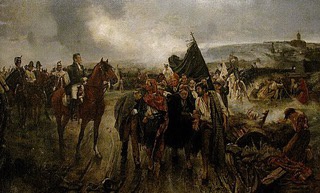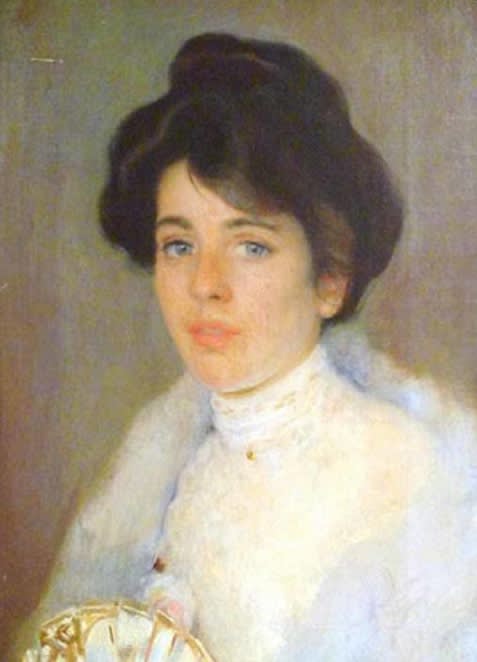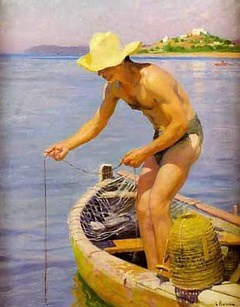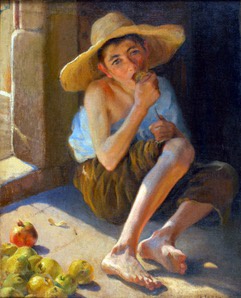-
Laureano Barrau
Barcelona, 1864 – Santa Eulàlia del Riu, 1957
El Columpio (The Swing)
c. 1901
Oil on canvas
100 x 75 cm. (40 x 30 in.)
Signed (L. Barrau) lower right corner
Awards
1884 - Pensió Fortuny in Rome given by the Ajuntament de Barcelona.
1888 - Second Medal at the Exposició Internacional de Barcelona and Exposició Universal Brussels
1891 - Soci del Saló de la Societat Nacional de Belles Arts, París
1892 - Tercera medalla Exposició Universal de París
1904 - Segon premi Exposició Universal de París
Museums
Museo Nacional del Prado, Madrid
Museu Nacional d’Art de Catalunya, Barcelona
Carmen Thyssen-Bornemisza Museum, Madrid
Víctor Balaguer Library, Vilanova i la Geltrú
Rafael Masó Foundation, Girona
Museu Barrau, Santa Eulàlia del Riu, Ibiza
Exhibitions:
Sala Parés, Barcelona (1901)
Provenance:
The artist; Sala Parés, Barcelona (1901); Private collection
From a point just outside the framework of the picture a powerful sun shines fiercely down onto a beachy landscape, generating a blinding reflection on the water at the horizon. The warm light bounces off surfaces and contours defining the shapes in the foreground against a backdrop of incandescent sand. The sky in the tones of lilac and violet anticipates the sunset. A young girl, in a plain white dress, inquiringly stares at the beholder – the painter, who perhaps interrupted her games – the intensity of the sun forces her to squint. She sits hanging between the two ends of a mooring-rope, her legs playfully dangling over the sand. The converging diagonals of the rope, capped by the bow of the fishing-boat, inflate the otherwise still composition lightening it. The shadows deformed by the uneven surface of the sand stretch the space. The palette is varied, but the different colours are softened in pastel tones, blending together harmoniously with the cooler shadows heating up in the golden light. The result is a delicate balance between movement and stillness, softness and saturation which is almost mesmerizing.
This painting is a beautiful and characteristic example of the work of Laureano Barrau. As with many Catalan painters of the twentieth century, Barrau has been largely overlooked in recent times. Nevertheless, the artist was greatly appreciated during his own lifetime, both nationally and internationally. In 1888 he was awarded a second medal at the Barcelona International Exhibition and a second prize at the Exposition Universelle in Brussels. He also won a third and a second medal (1892 and 1904 respectively), in the Spanish National Fine Arts Exhibitions. In 1891, aged only 28, Barrau received was made partner of the Salon of the National Society of Fine Arts in Paris. In 1929 he was named sociétaire of the Paris Salon.[1]
As recorded by his wife Berta Vallier in her biography of the artist, Barrau showed precocious ambition from a young age, declaring that he wanted to grow up to be “rey y dibujante”: “a king and draughtsman”.[2] “Draughtsman, colourist, painter, he was”, in
Vallier ‘s words,“king of his ideal, he was also king of his life, painting what he liked the most, where he wanted, without any hindrance, where he found more inspiration, completely free. And isn't that being a king like he wanted to be when he was a child?”.[3]
Following his dream, Barrau first studied at the Escuela de Bellas Artes (School of Fine Arts) in his hometown Barcelona, under the gifted portraitist and academicist Antonio Caba (1838-1907). His formative years culminated in an educational trip to Madrid, to study the Old Masters at the Prado.[4] At the age of twenty, the Barcelona City Council, recognizing his talent, granted him the Fortuny pension to continue his studies in Paris.[5] Here, he entered the highly competitive atelier of the charismatic academician Jean-Léon Gérôme (1824-1904), at the École des Beaux-Arts. In 1886 Barrau won another pension, the prestigious Prix de Rome, to fund his travel to the eternal city and study the Italian Masters. It is probably during his Italian journey that he painted this beautiful View of Venice, in which we can appreciate the painter’s early fascination with vibrant colours and plays of light and reflections (fig. 1).

Laureano Barrau, View of Venice, ca. 1887 (?).
The following year, 1887, Barrau won public acclaim in his native Barcelona with an ambitious painting of La rendición de Gerona (The surrender of Gerona), which shows how skillfully Barrau was able to invigorate the somewhat rigid formulae of history paintings conveying a sense of drama and pathos (fig. 2).

Laureano Barrau, The Surrender of Gerona, 1887
Despite his conventual academic training, Barrau was able to absorb and assimilate the lessons of the more prominent avant-garde movements of his day such as Realism and Impressionism.
Following the success of his rendición de Gerona, Barrau exhibited regularly at the Sala Parés de Barcelona, one of the most important galleries in Spain and the leading gallery in Catalonia. It was here in 1901 that El Columpio was first exhibited, attracting a favourable review in La Ilustración Artística which, at the time, was one of Barcelona’s most prominent art magazines.[1] Around the turn of the century, Barrau increasingly came under the influence of Spanish ruralism, which had in turn generated a specific Catalan movement; but Barrau, as always, adjusted the concept “to his artistic creed and to his nationalism … kneading in his palette the tones that would reflect the region since the types, scenes and pictures reproduce the way of being and the country-life of our nation.”[2] His luminist approach invites comparison with his better-known contemporary Joaquín Sorolla, with whom Barrau had, however, no documented contact.
In 1899 he married a beautiful Frenchwoman Marie Valier, who changed her name to Berta after meeting Barrau. His wife was to become the artist’s most important muse as well as being the subject of many portraits (fig. 3).

Fig 3. Laureano Barrau, Portrait of Berta Vallier, Ibiza, Museo Barrau.
After their marriage, the couple left Paris to settle in Caldetes (El Maresme, Barcelona). In October 1912 Barrau paid his first visit to Ibiza, following the recommendation of his artist-friend Frederic Rahola (1858-1919). Fascinated by its landscapes and people, Barrau spent long periods of time painting works inspired by his frequent travels to the island (fig. 4). In 1932, Barrau and his wife finally settled in Puig de Missa, in the town of Santa Eulària del Río (Ibiza), where the painter lived until his death on October 21, 1957 and where he is buried.

Fig. 4 Laureano Barrau, Eivissenca (Girl from Ibiza), post 1911.
Ibiza, Museo Barrau.
During his lifetime, Barrau frequently exhibited at national and international exhibitions, winning several awards. He held numerous solo shows in Barcelona,Madrid, Paris, Rome, and New York, and he featured in several collective exhibitions worldwide. In 1950, at 87, he staged his last exhibition at the Sala Busquets (Barcelona). After his death, Vallier published her husband’s biography and founded a museum in his name in the parish of Santa Eulària. In 2010, this museum was closed for conservation reasons and in May 2014 reopened in a new location. The new Barrau Museum features many newly restored paintings, part of the furniture from Barrau’s house, and ceramic objects that the couple had treasured throughout their lives. In 2016, the Saint Eularia City Council published an extensive monograph edited by Paloma Miguel y Bonet, which provides a detailed study of the painter’s life, style and influences and is the first catalogue of the painter’s oeuvre.
Barrau, who had always shown a marked fascination for painting snapshots of everyday life, taking a strong interest in folklore and local customs on his travels, found in Ibiza the perfect source of inspiration. His immersion in the simplicity of life on the island and his embracing of the locals’ close relationship with the natural world are reflected in many of his works from his later period such as the painting of the Young Boy Eating Fruit (fig.7) with its distant echoes of Murillo combined with a technique which owes much to the French Impressionists.
His keen observation and perennial fascination with light emerge also in the delicate depiction of El Columpio (The Swing). Although this picture was painted several decades before his move to Ibiza, the confident brushstrokes, the balanced use of colour and the mastery of light-effects display all the finest and most characteristic aspects of Barrau’s style and provide an exquisite foretaste of his later Ibizan paintings.

Figure 5. Barrau, Young fisherman.
Ibiza, Museo Barrau

Figure 6. Laureano Barrau, Fisherman.
Ibiza, Museo Barrau

Figure 7. Laureano Barrau, Young boy eating fruit.
Ibiza, Museo Barrau.
______________________
[1] His career is outlined in the painter’s obituary available online at: http://hemeroteca.lavanguardia.com/preview/1957/10/22/pagina-8/32770912/pdf.html (last accessed 13/06/20).
[2] Berta Vallier, La vida de Laureano Barrau, Ed. Ajuntament de Terrassa, 1960 quoted in Musas de Barcelona 2015 available online at: https://books.google.it/books?hl=it&id=ZKyUDwAAQBAJ&dq=la+musas+de+barcelona+berta+vallier&q=rey+y+dibujante#v=snippet&q=rey%20y%20dibujante&f=false (last accessed 13/06/20).
[3] Vallier, La vida de Laureano Barrau (1960).
[4] A. García Llansó, “Laureano Barrau”, La Ilustración Artística, 1036: 715.
[5] La Vanguardia. Diario Político de Avisos y Noticias. Órgano del Prtido Liberal de la Provincia de Barcelona, IV, 533 (29 October, 1884): 6.
[6] La Ilustración Artística, 1036: 715-717.
[7] Llansó, “Laureano Barrau”: 715.
Laureano Barrau, La ilustración artística, p. 715
Marta Camps Triay, Exposicions d'artistes catalans a Nova York 1900-1950, 2012
